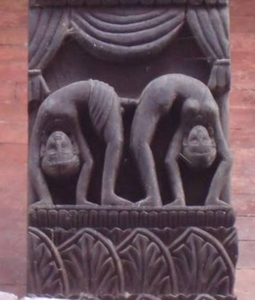Yoga: Gift of Hinduism to the World
- Sonal

- Oct 12, 2020
- 2 min read

The practice of Yoga is believed to have started with the very dawn of civilization. The science of yoga has its origin thousands of years ago, long before the first religions or belief systems were born.

In the yogic lore, #Shiva is seen as the first yogi or Adiyogi, and the first Guru or Adi Guru.
Several thousand years ago, on the banks of the lake Kantisarovar in the Himalayas, Adiyogi poured his profound knowledge into the legendary Saptarishis or "seven sages”.
The sages carried this powerful yogic science to different parts of the world, including Asia, the Middle East, Northern Africa, and South America.
Historical evidence of the existence of Yoga was seen in the pre-Vedic period (2700 B.C.), and thereafter till Patanjali’s period. The main sources, from which we get the information about Yoga practices and the related literature during this period, are available in #Vedas (4), #Upanishads(108), #Smritis, teachings of Buddhism, Jainism, Panini, #Epics (2), #Puranas (18), etc. Tentatively, the period between 500 BC - 800 A.D. is considered as the Classical period which is also considered as the most fertile and prominent period in the history and development of Yoga. Regular practice of Yog asanas and Pranayam has in many cases provided relief in various ailments.
Benefits of Yoga

Research and innumerable case studies show that Yog and Pranayam help control Acidity, Allergy, Anxiety, Arthritis, Asthma, Backache, Blood Pressure, Carpal Tunnel Syndrome, Cervical Sodalities, Constipation, Depression, Diabetes, Epilepsy, Fatigue, Gastric Disorders, Headaches, Heart Diseases, Obesity, Migraine, Sciatica Pain, Sinus, Weakness, etc.
The Mental Benefits

Helps relax and handle stressful situations easily. Teaches you to quieten the mind so you can focus your energy where you want it to go on a difficult yog aasan, on the tennis court or golf course, or in the office encourages positive thoughts, self-acceptance, and self-confidence.
The Spiritual Benefits
Builds awareness of the body, feelings, the world around, and the needs of others and empathy with nature. Promotes interdependence between mind, body, and spirit.
Hinduism stands on a foundation of six philosophical systems termed as “#Darshanas”. The system of Yoga as propounded by Patanjali, along with Vedanta, Samkhya, Poorva Mimamsa, Nyaya, and Vaisheshika constitutes these “Darshanas”.
Each of these Darshanas seeks to understand the workings of the universe, its relationship to Man and God, and the means by which a man can transcend the limitations imposed by it. It is for this reason that, at the very beginning of Yoga Sutras, Patanjali defines Yoga as a state wherein Atman or Innermost Self abides in its real nature. Hence, it is beyond doubt that the system of Yoga is an inseparable part of Hinduism.

Today, there is a cultural battle occurring in the media and academia, in which India’s civilization views are poorly represented. India’s yogic culture is under siege, in India itself, with campaigns against Hindu practices and festivals, neglect of temples, and a demeaning of Hindu symbols and deities.
Yoga is not secular and other world religions must recognize it, they must be grateful and obliged to Hindus for the same.









































Comments